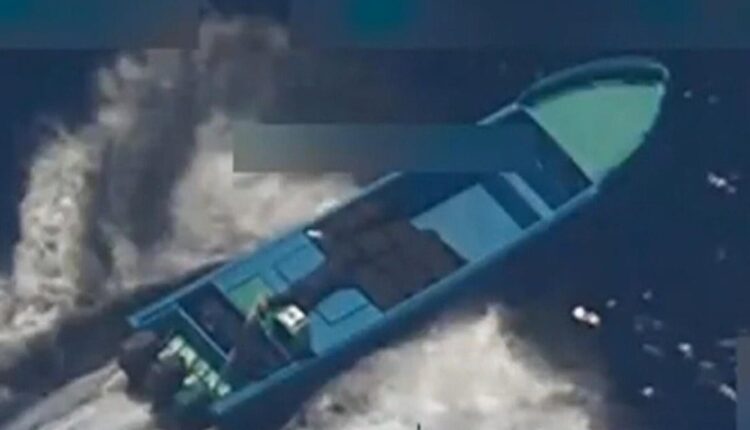Washington — The U.S. has been carrying out intermittent strikes on vessels alleged to be carrying drug smugglers and illegal narcotics in international waters off South American coastlines since early September.
President Trump and Defense Secretary Pete Hegseth say the boats were known to be involved in drug smuggling, and insist they have the authority to carry out the strikes without authorization from Congress. Mr. Trump has long decried the influence of drug cartels in the United States, although the lethal strikes represent the biggest escalation in his war on drugs.
Here’s what’s known about the Trump administration’s strikes.
How many boats have been struck?
As of Friday, Oct. 24, the Trump administration has publicly disclosed strikes on 10 vessels since the president revealed the first operation on Sept. 2.
The latest strike, on Oct. 24, was carried out against a vessel allegedly operated by Venezuelan gang Tren de Aragua that Hegseth said was trafficking drugs in the Caribbean Sea. Hegseth said the U.S. operation killed six individuals.
Where are they being targeted?
Most of the strikes have taken place in the Caribbean, although the operation recently expanded into the Eastern Pacific. Two strikes in the Pacific have been disclosed by the administration.
Several have occurred off the coast of Venezuela, which has been a key target in the president’s war on drugs, as has Colombia.
Are there plans for strikes on land?
Mr. Trump told reporters Thursday it’s possible that the U.S. may begin carrying out strikes on land. So far, the administration says it has only targeted vessels in international waters.
“The drugs coming in by sea are like 5% of what they were a year ago, less than 5%. So now, they’re coming in by land,” Mr. Trump said on Oct. 23. “And even the land is a concern, because I told them, that’s going to be next. You know, the land is going to be next.”
How many people have been killed in the strikes?
At least 43 people have been killed in the strikes as of Friday, Oct. 24, according to the numbers released by the Trump administration. The first confirmed strike on Sept. 2 in the Caribbean resulted in the largest number of casualties, killing 11.
Colombian President Gustavo Petro alleges an attack in September killed a fisherman, not a drug smuggler, and claims the U.S. has committed “murder.” Mr. Trump, in response, called Petro an “illegal drug leader” and said the U.S. is cutting off all aid to the country. On Friday, the Treasury Department imposed sanctions on Petro and members of his family.
Have there been any survivors?
There were two survivors in an Oct. 16 strike on a vessel in the Caribbean. The two survivors were repatriated to their countries of origin, Ecuador and Colombia, for “detention and prosecution.” The survivor turned over by the U.S. to Ecuador was released because authorities said they found no evidence that he had committed a crime.
The Colombian citizen who survived was hospitalized after being repatriated but will face prosecution. Interior Minister Armando Benedetti said he “arrived with brain trauma, sedated, drugged, breathing with a ventilator.”
How are the vessels being hit?
The strikes are being conducted by the U.S. military, although the military hasn’t disclosed tactical details of its operations. A source familiar with the operations said U.S. special operations forces are conducting the strikes. The Pentagon has used U.S. intelligence to carry out operations.
Is this legal?
The White House is required by the National Defense Authorization Act to notify Congress when it conducts a military attack. After a strike in mid-September, the administration sent a notice to Congress that called the three individuals who were killed in the strike “unlawful combatants.” This is the same term President George W. Bush’s administration used to describe al Qaeda and other terrorist networks. After the terrorist attacks on the U.S. on Sept. 11, 2001, Congress authorized the use of military force against terrorist organizations responsible.
Congress has not authorized the use of military force to target drug cartels.
The Trump administration has designated several drug cartels and gangs as terrorist organizations, including Venezuela’s Tren de Aragua, Mexico’s Sinaloa Cartel and El Salvador’s MS-13. In its notification to Congress, the White House said the drugs smuggled by these cartels kill tens of thousands of Americans each year and constitute an “armed attack” against U.S. citizens. It did not name any specific gangs or cartels. The president hasn’t indicated that he thinks he needs congressional authorization.
The president, asked on Oct. 23 by a reporter why he wouldn’t ask Congress to declare war and authorize the strikes, replied, “Well, I don’t think we’re going to necessarily ask for a declaration of war. I think we’re just going to kill people that are bringing drugs into our country. Okay? We’re going to kill them. You know? They’re going to be like, dead.”
Democrats and some Republicans in Congress worry the strikes could lead to a larger conflict in the Caribbean. GOP Sen. Rand Paul of Kentucky said he wonders why U.S. leaders “would glorify the idea of killing people without any sort of evidence presented as to who they are.” He says he wants to force a vote with a bipartisan group of senators to block the president from military action in the region unless explicitly authorized by Congress.
Colombian President Gustavo Petro has called U.S. strikes on alleged drug boats ineffective, since the strikes are largely targeting alleged lower-level smugglers.
“You have to capture the bosses,” he told CBS News in an exclusive interview.
What else is the Trump administration doing to combat drug trafficking from Latin America?
The Pentagon said on Oct. 24 that the U.S. is sending an aircraft carrier strike group to the waters off Latin America, an escalation that will dramatically increase the number of service members and ships dedicated to the Trump administration’s campaign to counter narcotics traffickers.


